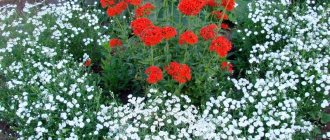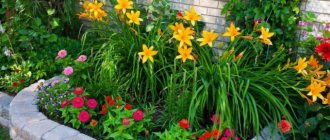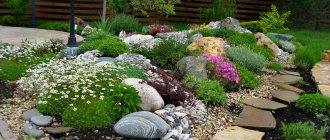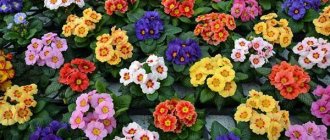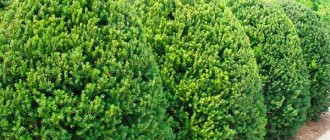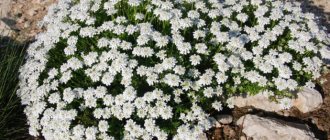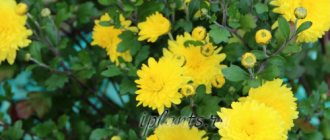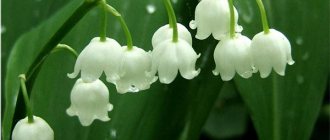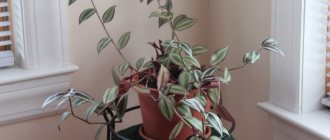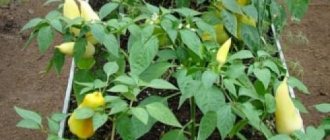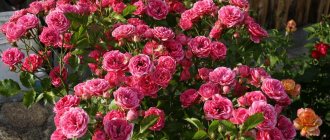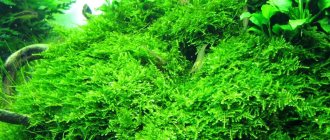Many people want to decorate their gardens. You can always plant a flower garden in a shady place in the garden layout. It is often said that flowers and other greenery do not like to grow in the shade; they prefer the sun. But this is not always true. Yes, many plants love the sun, but there are no less shade-loving plants. The presented flower bed diagrams will help solve the problem of planting plants in shady areas.
A dark area often prevents any gardener from creating a beautiful flower garden. But I really want to create a temple of beauty and aromas out of it, like the Optina flower garden, about which the Monk Macarius spoke: “Inhale the aroma of the flowers that bloom and delight the eye here, when the withered grass in the surrounding area is already drying up.”
What to plant in the shade?
In order to develop the design of a flower garden in front of the house, it is necessary to determine the amount of light falling on the site. It is worth thinking about what kind of soil is allocated for the flower garden. Some of the plants love shade. These are hosta, sedge, hellebore, Rogersia, fern, arizema, bitter weed and others.
Also, fir plants such as thuja, spruce, fir, and juniper love shady conditions. Many different deciduous shrubs. These include elderberry, turf, hawthorn and others.
A shady area of the garden with the right choice of shrubs will delight you with a lush green island and calm colors of flowers.
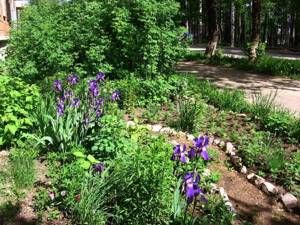
The choice of a shady area for a flower bed depends on how dry or wet the soil is in the selected area.
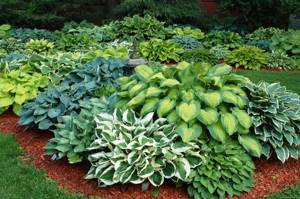
The low-growing hosta shrub is the queen of shady flower beds.
The size and shape of the future flower bed are of great importance. The shapes can be varied, ranging from simple geometric to a huge variety of free and sometimes unpredictable shapes.
These rules must be taken into account if the gardener wants to have a plot of continuous flowering from perennials. It is thanks to the right combination that you will be able to observe the splendor of flowering plants throughout the spring and autumn period. Provided the flower garden is diluted with conifers or simply tall herbaceous plants, as well as low-growing border plants from small shrubs such as periwinkle, this piece of the garden, like the Optina flower garden, will delight all year round not only with its appearance, but also with pleasant aromas.
However, when choosing plants for a continuous flowering flower garden, do not forget that their number should be consistent with the size of the area, since instead of pleasant and fragrant beauty you can get chaotic, ill-conceived collections of plants.
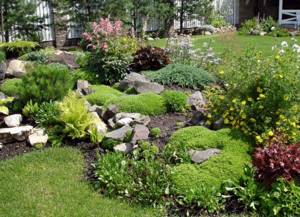
As in a fairy tale about an enchanted city, many types of hosta, primrose, and bodan look mesmerizing on the alpine hills.
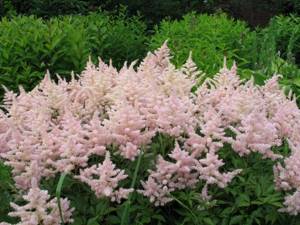
Many of the astilbe varieties will decorate a shady flower garden in the garden and near a pond.
Low-growing spring-blooming perennials look best in groups in the foreground. These include flowers such as snowdrop, primrose, and hyacinth.
Plants of medium height - tulips, foxgloves - are placed in the middle of the flowerbed, and plants such as the tulip look good individually, and not in a group. In the background, tall plants such as sedum, chrysanthemum and others will naturally grow. Ground cover grasses are planted between them. (Fig.2)
Shadow representatives of the plant world
The most difficult living conditions are for plants planted in the “shade” and “deep shade” zones. Therefore, flower beds here are decorated not with wildly flowering perennials, but with more modest decorative foliage plants. They are not so spectacular, but they have the most important advantage - shade tolerance.
All plants for shady areas can be divided into 2 groups:
- shade-loving - they develop worse in the sun than in the shade: their leaves burn easily and change their natural shade. This includes most varieties of hosta, ferns, periwinkle, dodecatheon;
- shade-tolerant - these comrades only put up with the lack of light. That is, I don’t mind receiving a greater degree of insolation, but I have to be content with what I have. Prominent representatives of this group: aquilegia (catchment), astilbe, violas.
Choosing plants for deep shade
The most difficult thing is to plant a flower garden in deep shade: under old trees or between buildings. Shade-loving plants for flower bed No. 1 are ferns . They are not at all demanding on the quality and duration of lighting, and do not require scrupulous care. Ostrich, shieldweed, female nocturnal fern - all these forms of ferns, creating a voluminous background, will go well with ground cover, spring ephemerals, primroses, and hosts.
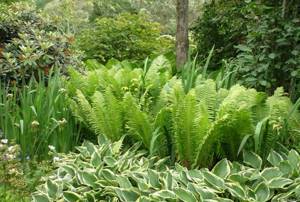
Shade-loving flowerbed with ferns and hostas
Another Spartan is the hoof . This is a ground cover plant with hoof-shaped leaves that grows best under the dense canopy of spruce and aspen. Clefthoof creates a dense green mat, so it can quickly disguise “gaps” in the flower garden.
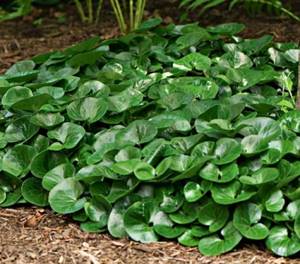
Clefthoof is an evergreen plant, its leathery green leaves are well preserved under the snow.
Hostas can withstand dense shade , especially varieties with dense leathery leaves of green or blue shades, for example, “Queen of the Seas”, “Deep Blue Sea”, “Blue Mouse Ears”. Blue hostas are a real delight: their leaves are covered with a “waxy” coating, giving the plant a bluish or ashen tint. At the same time, most variegated hostas are sensitive to a lack of light and in deep shade can lose their color and become monochromatic.

In the foreground of the composition are blue hostas with a “waxy” coating on the leaf blades
Plants for the “shade” zone
The list of plants for this shady zone is more extensive. hostas with white, golden, and yellow borders on the leaves can take root here In June-August, hostas become not only decorative foliage, but also flowering. Flowers open on long stems in the center of the bush, which can have different colors (white, cream, purple) depending on the variety.
Periwinkle grows quickly under trees , covering the ground with dense leaves and small flowers of blue, purple, white, pink, and red shades. Among the lush carpet of periwinkle, you can plant various perennials, including hostas, ferns, and shade-tolerant herbs.
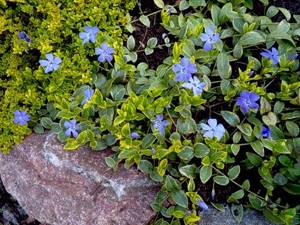
Periwinkle quickly weaves through the free space, creating an original flowering mat
Loves the shade and moist soils of the magnificent dicentra , blooming with bright pink “hearts” with a white droplet in the center. In a shady flower bed, the dicentra bush often becomes a background element, near which the main flower arrangement is placed.
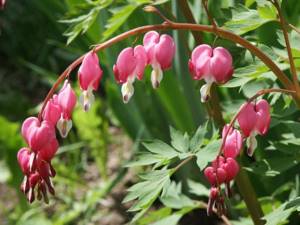
Dicentra splendid can grow up to 1 m in height
Ephemeral plants are traditionally planted under trees that create openwork shade: anemones , corydalis , crocuses , muscari , scillas , etc. All of them have a short growing season and bloom in the spring, at a time when there are no leaves on the trees. At this time, even those areas that will become “shady” in the summer are sufficiently illuminated by sunlight.
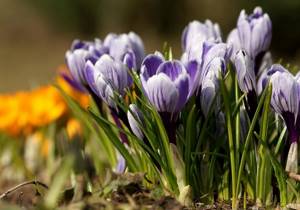
Crocuses and other ephemerals will decorate the flower bed under the trees in spring
The openwork sliding shadow under deciduous trees and young pines is also suitable for garden orchids - lady's slippers . They try to plant them in moist, nutritious soils with significant shading. No aggressive neighbors, like periwinkle, should be planted next to delicate shoes. But hostas, astilbes, sedges, tiarellas are best suited for the role of companions.
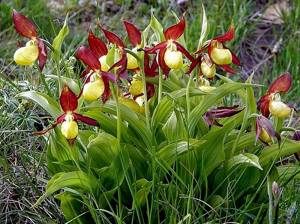
Lady's slippers are a capricious culture. It requires loose, permeable soils and mandatory shading.
Tiarellas are forest beauties with a dense bush and cream flowers on high stalks. With age, tiarella bushes become more and more beautiful, so it is not recommended to frequently divide and replant them. When combined with hostas and ferns, tiarellas can create a very effective shade composition.
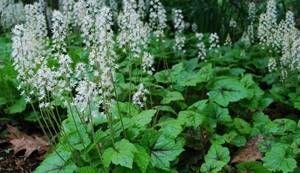
Tiarella grows quickly, forming a dense, wide ground cover in 2-3 seasons.
heuchera, is similar to tiarella . The triangular leaves of various colors make the plant especially attractive. In some varieties they are almost white, in others they are red, in others they are dark purple. Often the color of the leaf blade is uneven, due to contrasting veins, color splashes in the center or original border. Heuchera flowers are small, pink, red or white. Heuchera and tiarella are often used to create the border of a shade-loving flower bed, as they form dense bushes that do not fall apart and retain the shape of the flower arrangement.
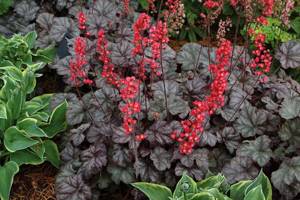
Heuchera is valued for its spectacular leaves of various colors, compact dense bush shape and modest but graceful flowering.
The heroes of a flowerbed in the shade can be conifers, for example, Lawson cypresses In the open sun, their branches burn, but in the shade they feel great. Many varieties of pea cypress grow well in shade: “Filifera”, “Squarrosa”, “Plumosa”. spruce , yew and juniper trees are good in shady flower beds .
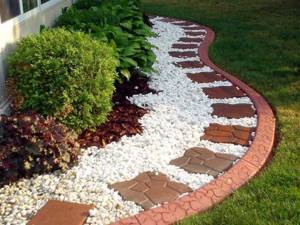
A juniper bush among hosta and heuchera is a worthy decoration for a flower bed near the house
On the verge of light and shadow: plants for semi-shaded places
The choice of plants for semi-shaded flower beds is quite large. The ideal ones are those that are able to stay in the sun for 4-6 hours a day, and the rest of the time in the shade. Aquilegia , viola , aconite , bergenia , rhododendron , etc. develop well in such conditions
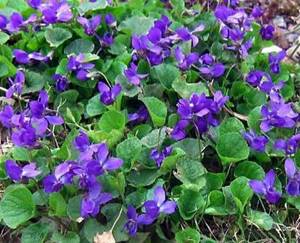
Violas are shade-tolerant biennials that bloom all summer, even in partial shade.
In a semi-shaded flowerbed you can grow many annuals: petunias , lobelias , torenias , balsams , etc.
Basic rules for arranging a flower garden
Decorating a flower garden requires advance planning. Flowers have the ability to delight with their beauty one by one; in addition, the height or width of some plants may make it difficult for others to show themselves in all their glory.
To do this, you need to analyze the following parameters:
- flowering time;
- degree of growth;
- degree of endurance to low temperatures;
- drought resistance;
- type of soil for the flower garden: alkaline or acidic;
- size.
Types of flower beds
In order to arrange a flower garden in front of your house with your own hands, you need to know a few rules. The arrangement of flower beds makes you wonder if there is a shadow around and what creates it. There are different types of flower beds:
- Rabatka. It is she who plays a big role in masking structural defects. Lush plants cover all the errors and irregularities.
- A heterogeneous flower bed that stretches along the path. Plants in a border always look good. These are plants such as hawthorn, petunias, marigolds.
- “Blooming geometry” will look good against the background of a lawn under a flower bed. The shape of the flower bed should be a perfectly even figure: square, circle, oval, etc. Usually they are located somewhere on a hill, which makes it possible to better see the flowers.
- Mixborder. Like the Optina flower garden, it is aimed at living in harmony and joy. Flowers do not fight for water and do not occupy someone else’s space; they have enough sunlight.
- The flowerbed is the main accent of the garden. It should be based not only on bright, catchy flowers, but also small, calmer tones. So, blue, green, violet and lilac colors are chosen for the background. And to create elegance and attractiveness, yellow, red, orange and pink. White, pale blue and soft yellow flowers will help decorate empty spaces. Decorating a flower garden forces you to take into account the laws of color, which can make your soul rejoice and your gaze stop at every moment. The Optina flower garden was developed according to these same principles, as evidenced by its popularity. The color combinations there inspire and pacify, and do not create aggression.
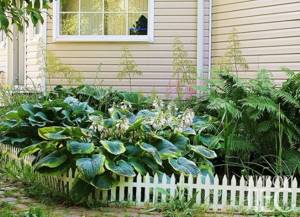
Even in a small, shaded area in front of the house, you can recreate a green taiga island by planting unpretentious fern shrubs, hostas, and astilbes.
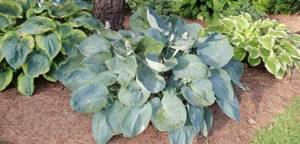
The low-growing hosta bush, similar to an ancient giant tortoise, will delight gardeners with 100 shades of green: from soft green to Moroccan emerald.
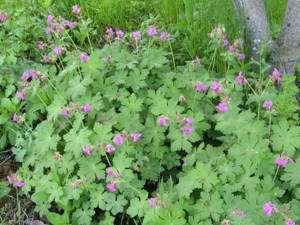
A soft green bather with purple bells easily takes root in a shady, damp area of the garden.
Flower garden in the shade: studying the illumination of the garden
When studying a site or a fragment of it where there will be a flower garden, it is necessary to correctly assess the level of illumination in the garden at different times of the day. Then for each zone of the garden it will be possible to select the appropriate plants and combine them with a single concept. Light starvation, if plants are chosen incorrectly, will lead to loss of their decorative properties. The second important point is determining the quality of the shadow and taking into account its seasonality. Different levels of illumination can be divided into three groups: light (light) shadow, which is formed from the sparse crowns of rowan trees, pine trees, medium, or partial shade, under the crowns of trees in mixed forests and dense, characteristic of spruce forests and places near tall buildings and fences.
The density of the shade may vary depending on the time of year. Thus, in the spring, under the canopy of deciduous trees and shrubs, many crops, which are called ephemeroids for their short spring growing season, manage to bloom brightly: galanthus, scylla, chionodox, white flowers, corydalis, etc. For most of the year they are dormant.

Horny goat weeds in a shady flower garden
Arrangement of flower beds in semi-shaded places
The tallest is the highlander. Its lush bush grows up to 2 m in height. And the large panicle-shaped inflorescences resemble clouds with their white color. It blooms for approximately 1.5 months, starting in June. However, even after it fades, the inflorescences still continue to attract the eye. The same tall perennial veronicastrum has lilac inflorescences. In front is astilbe, which blooms in July, has large inflorescences and can make a flower garden beautiful even with daylily. Designing a flower garden requires that the bush called loosestrife have pink flowers. These plants thrive in both partial shade and full sun. But blue hostas cannot tolerate sunlight. With its abundance, their beautiful large leaves lose their varietal color and become monochromatic and green.
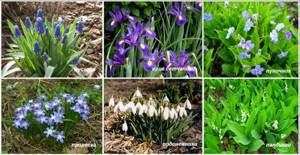
Flowers for a shaded, damp area of the garden.
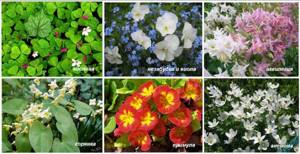
Plants for rock gardens and shady areas.
Plants for flower gardens in light shade and partial shade
Let us dwell in more detail on plants that will feel comfortable under varying degrees of illumination. Plants in light partial shade usually have a wide leaf blade. They can be very different, including very tall, such as elecampane and Volzhanka, which allows you to create lush flower beds from perennials. Perfect for such places are blood-red heuchera, knotweed, tradescantia, astrantia, jagged buzulniki, Przhevalsky, primrose, hoofweed, geranium.
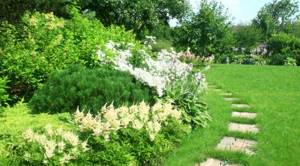
Astilbes, hostas and bells
Hosta is considered the best shade plant. A truly stunning and versatile plant with all sorts of foliage textures and a huge range of shades to choose from. These are very large with leaves of different shades and textures, which can be used in volumetric compositions together with tall perennials, and low ones, which will play the role of ground cover plants.
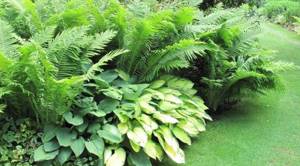
Hostas and ferns
But I would like to mention several more groups of plants that play an equally important role in shady compositions. Varieties of bellflowers: milky-flowered, crowded, broad-leaved, peach-leaved, mountain goat weed and brunners will add a unique charm to semi-shade mixborders. Irreplaceable plants include beautiful dicentra, meadowsweet, daylilies, and loosestrife.
The undoubted favorite of the shade, astilbe, deserves special attention. It is unpretentious, frost-resistant, multifaceted. The spectacular foliage from the moment it blooms in May contrasts perfectly with all the shade crops - mountain weeds, ferns, hostas, bergenia, astrantia, etc. During the flowering of astilbe (from the end of June until the second half of August), the garden is filled with its delicate aroma. It gives the shady flower garden a magnificent range of shades: from snow-white to dark garnet. It is astilbe that gives the garden a full range of pink, crimson, lilac tones of varying saturation. Very different shapes of inflorescences: from diamond-shaped and conical to openwork drooping.
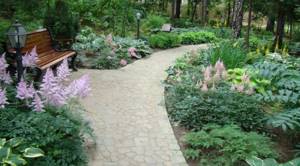
Astilbes in a shady flower garden
Bells are undeservedly little used in shady flower beds. A set of bells - typical representatives of the shady flora of our forests - allows you to prolong the flowering of a shady flower garden and complement its palette with delicate white, blue, and dark blue tones. Tall bells broad-leaved, rapunzel-shaped, peach-leaved, milky-flowered, nettle-leaved look natural in shady flower beds of a natural style. They self-sow and gradually inhabit the garden area on their own. The dotted bell looks great in combination with hostas. Its large pinkish drooping flowers decorate the flower garden with abundant blooms from June to August.
Carpathian and round-leaved bells will decorate the foreground of the flower garden even longer. It is impossible to do without geraniums in a shady flower garden, another typical representative of the forest flora of our strip.
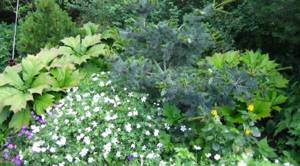
Rogersia and geraniums
From the significant assortment of these plants, I would highlight the unpretentious and fairly decorative varieties of blood-red, large-rhizome, and Himalayan geraniums. Geranium can be used as a ground cover plant, which is an excellent backdrop for architectural plants such as large hostas, or as a border plant. Together with low-growing dicentras, mountain weeds, and lungworts, it will look great in the foreground. However, you need to remember that these perennials will bloom mainly at the beginning of summer or at its height. Autumn flowering in a shady flower garden is very problematic. The exception is Japanese anemone and its varieties, black cohosh.
Flower garden for shady places
Often a place is chosen for a flower garden near the fence, where there is usually an empty space. You can plant chebushnik right next to it. It is quite tall, has pink flowers, which will look good against the background of a plain fence. Chebushniks come in several types and have inflorescences of different colors, but their main attraction is the aroma of the flowers, which is different for each variety. Foxglove - this plant will delight the gardener for 2 years with its large pinkish flowers.
Lupins are perennial plants. They bloom in June. Pale yellow flowers are collected in brushes. However, when they fade, they have an unsightly appearance. Therefore, such flowers should be planted in small groups. In front you can plant a cuff and incense. The fluffy round leaves of the cuff look great next to the leaves of the bergenia. They are large, dark green, and have a shiny appearance. The cuff, starting in June, blooms all summer until August. Its small pale yellow flowers are collected in an airy inflorescence. Daylilies look very beautiful against the background of this entire composition. It is best to remove their small yellowish flowers as soon as they fade.
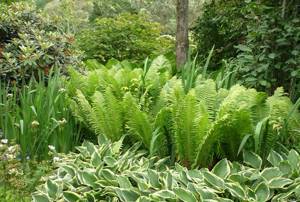
Plants for rock gardens and shady areas.
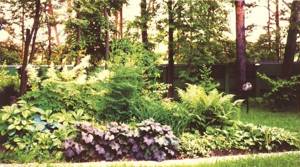
Near Moscow region, centuries-old spruce trees, a country village, an alpine hill in a shady place, carefully tended by a gardener. Find familiar plants.
A site about the garden, cottage and indoor plants.
A mixborder is a flower garden made up of a variety of perennials. The most effective are mixed borders in which some plants bloom continuously throughout the season. Such a dynamic, interesting corner of the garden will never get boring and will always attract attention. This is why mixborders are so popular in European gardens.
There is also the other side of the coin - creating a constantly blooming mix is not so easy. After all, you need to take into account many factors: a combination of plants in shape, height, growth rate and flowering period. In addition, they all must have similar biological requirements. Only by correctly selecting all these variables can you create the ideal equation for the beauty and harmony of your flower garden.
And creating a flower garden for a shady place
- the task is even more difficult, since many types of plants, although they grow in the shade, bloom in such cases rarely and sparingly. This is understandable: in a shady garden, pollinators, in particular bees, are rare guests. Nevertheless, a constantly blooming front garden in the shade is a completely doable task.
All flowering plants that can be planted in the shade are divided into two groups: shade-tolerant and shade-loving. Their main difference is that some, as the name suggests, only tolerate shade, while for others these are the most comfortable growing conditions.
EVERYTHING YOU NEED FOR THIS ARTICLE IS HERE >>>
Shade-tolerant plants grow in the shade, but feel more comfortable with light, partial shade from the daytime sun. In a shady garden they do not produce abundant blooms. A striking example of this is varietal daylily. In the shady zone, its bush will be lush and beautiful, but it will bloom rarely.
Rules for creating continuous flowering
Plants can grow very large over time, and the beauty of the flower garden in front of the house will be hidden in greenery, so it is important to plant perennials at a large distance from each other. Initially, you can fill in between them with annuals.
Until the perennials grow to the required size, it will be clear whether the gardener has chosen the right place for these plants.
Flowers that have faded and lost their attractiveness are best surrounded by lower plants. For example, hostas or daylilies can be planted near daffodils.
Flower garden design in front of the house
Every gardener, when planting flowers, has the goal of enjoying the beauty of the greenery around him and being in harmony with nature.
You can plant a magnificent flower garden in front of your house with your own hands, but before starting work you need to make sure that the diagram corresponds to the real area, mark the boundaries, and fertilize the soil.
It is advisable to plant plants sparingly, as they will grow.
Upon completion of the work, it is necessary to set up the border, because... there is a danger of trampling future beauty.
If you are not lazy in caring for the flowers near your house, watering and fertilizing the soil in a timely manner, removing weeds and faded buds, then arranging flower beds in the garden will create a small corner of happiness that will delight all its inhabitants with its appearance.
